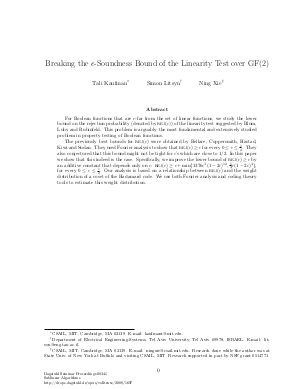Breaking the $\epsilon$-Soundness Bound of the Linearity Test over GF(2)
Authors Tali Kaufman, Simon Litsyn, Ning Xie
-
Part of:
Volume:
Dagstuhl Seminar Proceedings, Volume 8341
Part of: Series: Dagstuhl Seminar Proceedings (DagSemProc) - License:
 Creative Commons Attribution 4.0 International license
Creative Commons Attribution 4.0 International license
- Publication Date: 2008-11-25
File

PDF
DagSemProc.08341.3.pdf
- Filesize: 194 kB
- 17 pages
Document Identifiers
Subject Classification
Keywords
- Linearity test
- Fourier analysis
- coding theory
Metrics
- Access Statistics
-
Total Accesses (updated on a weekly basis)
0Document
0Metadata
Abstract
For Boolean functions that are $epsilon$-far from the set of linear functions,
we study the lower bound on the rejection probability (denoted by $extsc{rej}(epsilon)$) of the linearity test suggested by Blum, Luby and Rubinfeld.
This problem is arguably the most fundamental and extensively studied problem in property testing of Boolean functions.
The previously best bounds for $extsc{rej}(epsilon)$ were obtained by Bellare,
Coppersmith, H{{a}}stad, Kiwi and Sudan. They used Fourier analysis
to show that $ extsc{rej}(epsilon) geq e$ for every $0 leq epsilon leq
frac{1}{2}$. They also conjectured that this bound might not be tight for
$epsilon$'s which are close to $1/2$. In this paper we show that this indeed is
the case. Specifically, we improve the lower bound of $ extsc{rej}(epsilon) geq
epsilon$ by an additive constant that depends only on $epsilon$:
$extsc{rej}(epsilon) geq epsilon + min {1376epsilon^{3}(1-2epsilon)^{12},
frac{1}{4}epsilon(1-2epsilon)^{4}}$, for every $0 leq epsilon leq frac{1}{2}$.
Our analysis is based on a relationship between $extsc{rej}(epsilon)$ and the
weight distribution of a coset of the Hadamard code. We use both Fourier
analysis and coding theory tools to estimate this weight distribution.
Cite As Get BibTex
Tali Kaufman, Simon Litsyn, and Ning Xie. Breaking the $\epsilon$-Soundness Bound of the Linearity Test over GF(2). In Sublinear Algorithms. Dagstuhl Seminar Proceedings, Volume 8341, Schloss Dagstuhl – Leibniz-Zentrum für Informatik (2008)
https://doi.org/10.4230/DagSemProc.08341.3
BibTex
@InProceedings{kaufman_et_al:DagSemProc.08341.3,
author = {Kaufman, Tali and Litsyn, Simon and Xie, Ning},
title = {{Breaking the \$\backslashepsilon\$-Soundness Bound of the Linearity Test over GF(2)}},
booktitle = {Sublinear Algorithms},
series = {Dagstuhl Seminar Proceedings (DagSemProc)},
ISSN = {1862-4405},
year = {2008},
volume = {8341},
editor = {Artur Czumaj and S. Muthu Muthukrishnan and Ronitt Rubinfeld and Christian Sohler},
publisher = {Schloss Dagstuhl -- Leibniz-Zentrum f{\"u}r Informatik},
address = {Dagstuhl, Germany},
URL = {https://drops.dagstuhl.de/entities/document/10.4230/DagSemProc.08341.3},
URN = {urn:nbn:de:0030-drops-16971},
doi = {10.4230/DagSemProc.08341.3},
annote = {Keywords: Linearity test, Fourier analysis, coding theory}
}
